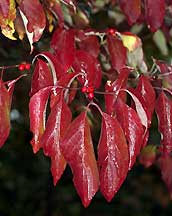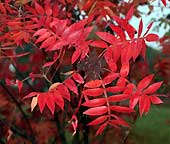
For those of us that live in the Ozarks, the fall is a time when many trees change from the monotonous green of spring and summer to various shades of reds, yellows, oranges, and browns. Unlike the coastal regions and south into subtropical to tropical regions, the broad-leaf trees in the temperate regions such as the Ozarks are unprotected from the freezing temperatures that occur during the winter months. Broadleaved trees must shed their leaves prior to the onset of winter to insure they will survive.
 Dogwoods that bring color to the landscape comprise a large number of deciduous woody plants (shrubs and trees). Many grow randomly, others are ornamental.
Dogwoods that bring color to the landscape comprise a large number of deciduous woody plants (shrubs and trees). Many grow randomly, others are ornamental.
As light intensity and day-length start to change in the late summer and early fall, leaves of deciduous plants begin to undergo physiological changes. Pigments once masked become dominant or new pigments are produced.
Chlorophyll is the primary pigment of photosynthesis, the process of converting light energy from the sun to chemical energy in the form of sugars stored and used during the tree's winter dormant period. Leaves are green during the primary photosynthetic period because chlorophyll is the dominant pigment and reflects green light.
Carotenoids are pigments that produce some brown, yellow and orange colors. The orange colors come from a type of carotenoid pigment called carotene (also what results in the orange color of carrots). The yellows come from a carotenoid pigment called xanthophyll. Both carotene and xanthophyll are common pigments also found in flowers, the peel of the banana, and even egg yolks.
Both chlorophyll and carotenoids are located within a special organelle of the cell called the chloroplast. During the primary photosynthetic period of the year, chlorophyll is continuously produced and masks the carotenoids.
 Sumac is the common name of a woody plant that sometimes is tree-like and often provides the attractive red color in a woodland setting. It is recognizable by its dense clusters of reddish brown fruit called drupes.
Sumac is the common name of a woody plant that sometimes is tree-like and often provides the attractive red color in a woodland setting. It is recognizable by its dense clusters of reddish brown fruit called drupes.
The third pigment, the anthocyanins, produce reds and blues, such as found in strawberries and blueberries respectively. These pigments are produced in the fall in response to light and excess sugars in the leaf cells.
As day length decreases and night length increases, chlorophyll production is reduced and eventually no longer produced. This allows the carotenoids to be expressed and become visible as colors of orange, brown, and yellow.
The vascular system (the “veins”) that move fluids into and out of the leaves will eventually be sealed off as a special layer of cells at the base of the leaf stalk (petiole) form. This traps sugars in the leaves resulting in the production of anthocyanins and reds to be expressed. The special cells at the base of the leaf stalk eventually become a weak zone. Wind will cause the leaves to break from their supporting branch and fall.
The oaks of the Ozarks generally produce reds, browns or reddish-brown colors and tend to shed their leaves from late fall into the spring after other species have long lost their leaves. The brown colors of oaks are the result of tannins (a waste product of the leaf). Oaks along the coast are generally evergreen, only losing a few leaves at a time.
A variety of trees reflect this magnificent color palette. Red maples will have red to bright red leaves in the fall while the leaves of sugar maples turn a reddish-orange. The leaves of hickories generally turn a yellowish or bronze color, and dogwoods have leaves that become reddish to purplish-red.
Generally in the Ozarks, the leaves reach their peak in color around mid-October. This year, they have peaked a little later due to the dry spring and summer.
Soon the last leaves will drop, and the trees will reveal their branching system of stems. So if you want to see the colors, don’t put it off much longer. Take a drive through southern Missouri, northern Arkansas or eastern Oklahoma and enjoy the reds, yellows, oranges, browns and their subtle shades.






Comments